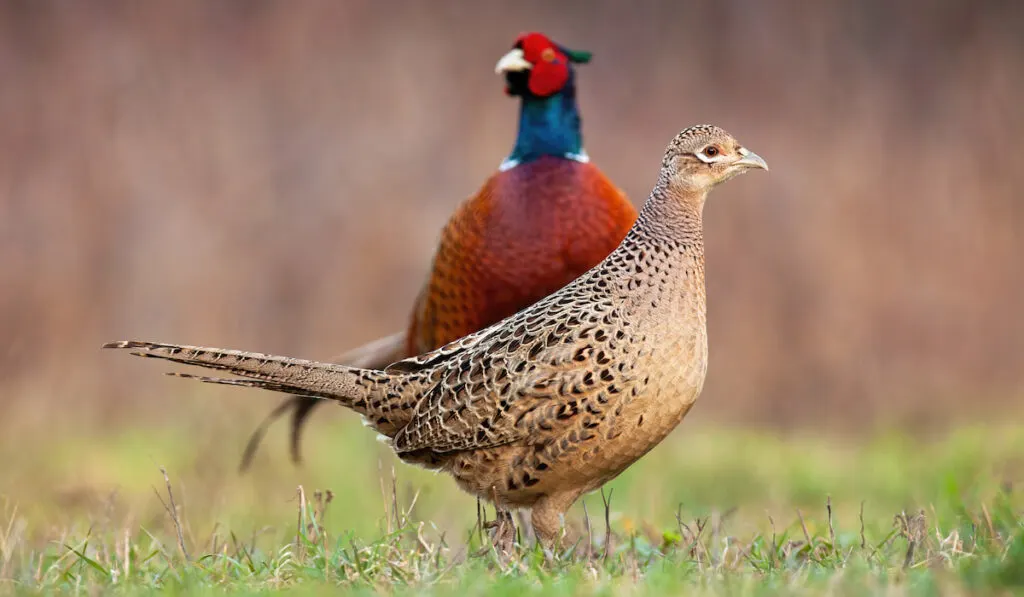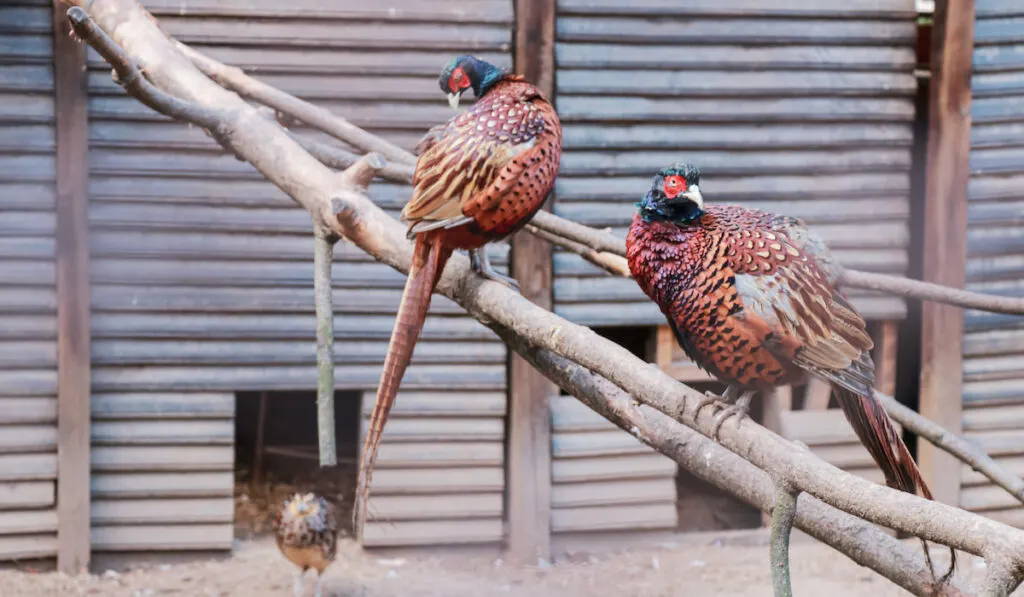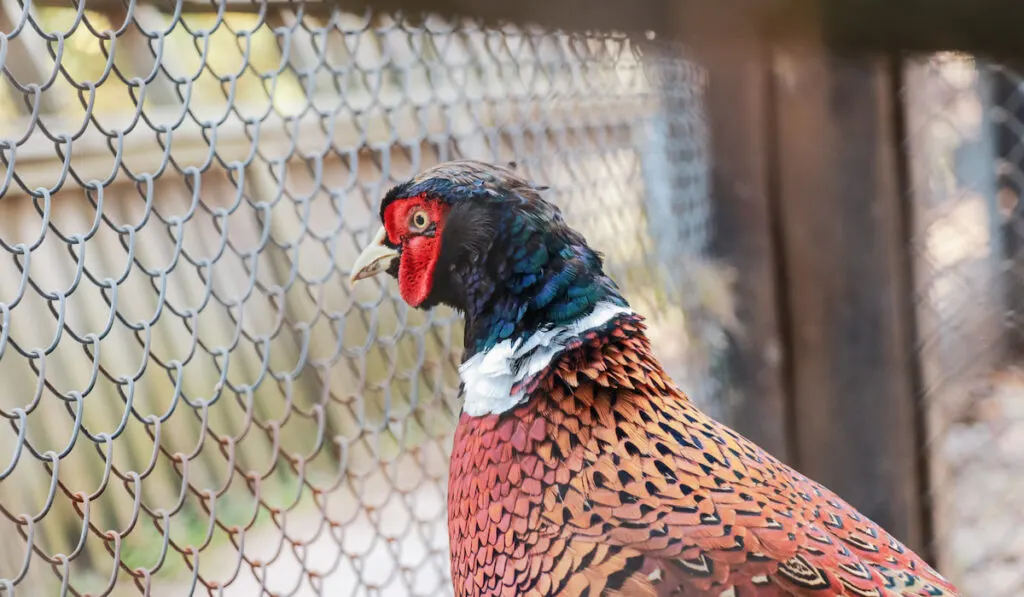In most cases, birds like swans, geese, and eagles mate for life. But what about pheasants? Do they fall in this same class?
Do pheasants mate for life? No, pheasants do not mate for life.
Pheasants are polygamous – a single male pheasant will mate with several females in its lifetime.
In a polygamous species like pheasants, competition for mates can be intense, which results in the evolution of odd traits in male birds.
The subsequent paragraphs will shed more light on the mating behavior of pheasants. This article will also discuss tips on how to adequately house pheasants.

Table of Contents
Pheasants Mating practices
The typical pheasant mating order involves one male and multiple females. So, pheasants do not mate for life.
Polygamy drives competition in male pheasants.
To survive the tussle, pheasant roosters have gained odd traits through evolution.
These traits are meant to impress females but can become maladaptive in some of these birds.
For instance, they may leave the male pheasants at greater risk of being attacked by a predator.
However, in terms of sexual selection, these traits are favorable, which is why they remain in the population.
How Many Females per Male?
As we already mentioned, pheasants are polygamous, and a single male pheasant can mate with several females.
They typically maintain this mating group throughout courtship and nesting.
A male pheasant may have 2-18 females. However, this study posits that farmers typically do not go beyond 10 females per male. (source)
Pheasants breed seasonally, and by early spring, male pheasants will begin to establish crowing or breeding territories.
These territories do not usually have definite boundaries and are relative to other males’ territories.
Female pheasants, on the other hand, are not territorial.
A female pheasant will usually have a monogamous relationship with a single territorial male each season.
Female pheasants often choose a dominant male who can, for instance, offer protection.

Does This Change Based on the Type of Pheasant?
Our search revealed no correlation between the types of pheasants and their ideal sex ratio.
However, the sex ratio of pheasants may be affected by the type of housing provided for them.
Generally, flocks bred outdoors have a lower female to male ratio than those raised in controlled indoor environments.
Will Male Pheasants Fight if Kept Together?
Yes, male pheasants of the same species will fight if kept together, especially if there is a female amongst them.
Pheasants are a very territorial species, and most times, you should keep only one male per species in your aviary.
Nonetheless, you can mix and match different species of male pheasants. When doing this, ensure you mix species with differing nesting levels.
Also, consider having varying primary sources of food when you house multiple species of male pheasants.
When the breeding season begins, male pheasants become strongly territorial.
They defend their territory using various deterrent sounds, including squawks, crowings, and screeches. Male pheasants also fight each other if necessary, using the sharp spur behind their legs as a lethal weapon.
Tips for Housing Pheasants
Pheasants are pretty active, and if you do not contain them properly, they fly, walk, or run away.
The housing for pheasants must be perfect so that they are comfortable and safe. Without proper housing, pheasants can become prone to harsh weather conditions and predators.
To house a pheasant, you do not need to build a new coop. You can use an old chicken coop with some adjustments.
You can also get a customized coop or make one yourself. Whatever option you decide on, you need to consider all the necessary features.

Here are a few tips on housing pheasants:
- Firstly, ensure the aviary has enough space for the birds to thrive. Ensure the space per bird is at least 20 square feet. If your aviary is overcrowded, it can lead to cannibalism.
- Ensure you provide enough cover for your pheasants. Set up the aviary in an area with weedy vegetation and natural green grass. If the land in the area for the aviary is vacant, you can plant millet and oats.
- You should also consider ventilation. If there is no proper ventilation, the pheasants may become stressed, and they may even suffocate. Sufficient ventilation makes it easy to overcome any issue with diseases, dirt, moisture, and smell.
You certainly do not want to see your pheasants die of heatstroke in the coop or freeze to death in chillers.
Therefore, your aviary should have large fans and wired windows to enable proper ventilation.
- Pheasants also require some shade. You can get some snow fencing, roofing materials, or a tarp to create a shaded area in part of the coop.
- Ensure you cover your aviary with wire, nylon netting, or both.
- Install the fence about 10-20 inches into the ground. This will ensure predators cannot dig their way in from under the barrier.
- Cover the topsoil of the aviary with about 4-6 inches of sand base. Sand is the best option for this because of the ease of cleaning and disinfection. Besides, you can rake it regularly while cleaning the aviary and it drains well.
Ensure you install a border in the aviary to help secure the sand in place.
When looking to get sand for the coop’s sand base, opt for sand sterilized for children’s sandboxes.
You can also get builder’s sand containing a tiny amount of agricultural lime. The lime helps to absorb odors and prevents bacteria.
Final Take
Pheasants are polygamous birds.
A male pheasant will mate with multiple females throughout the breeding and nesting period.
Male pheasants are also very territorial hence keeping many males of a single species is not ideal.
You can mix and match if you decide to have more than one male pheasant. Although, there are a few other things you need to consider.
Resources
- https://thepoultryguide.com/raising-pheasants-as-a-pet/
- https://science.jrank.org/pages/5132/Pheasants.html
- https://meyerhatchery.zendesk.com/hc/en-us/articles/360034721091-Raising-Pheasants-101
- https://forum.americanexpedition.us/common-pheasant-information-facts-photos-and-artwork
- https://animaldiversity.org/accounts/Phasianus_colchicus/
- https://www.pheasant.com/resources/support-faq/breeding
